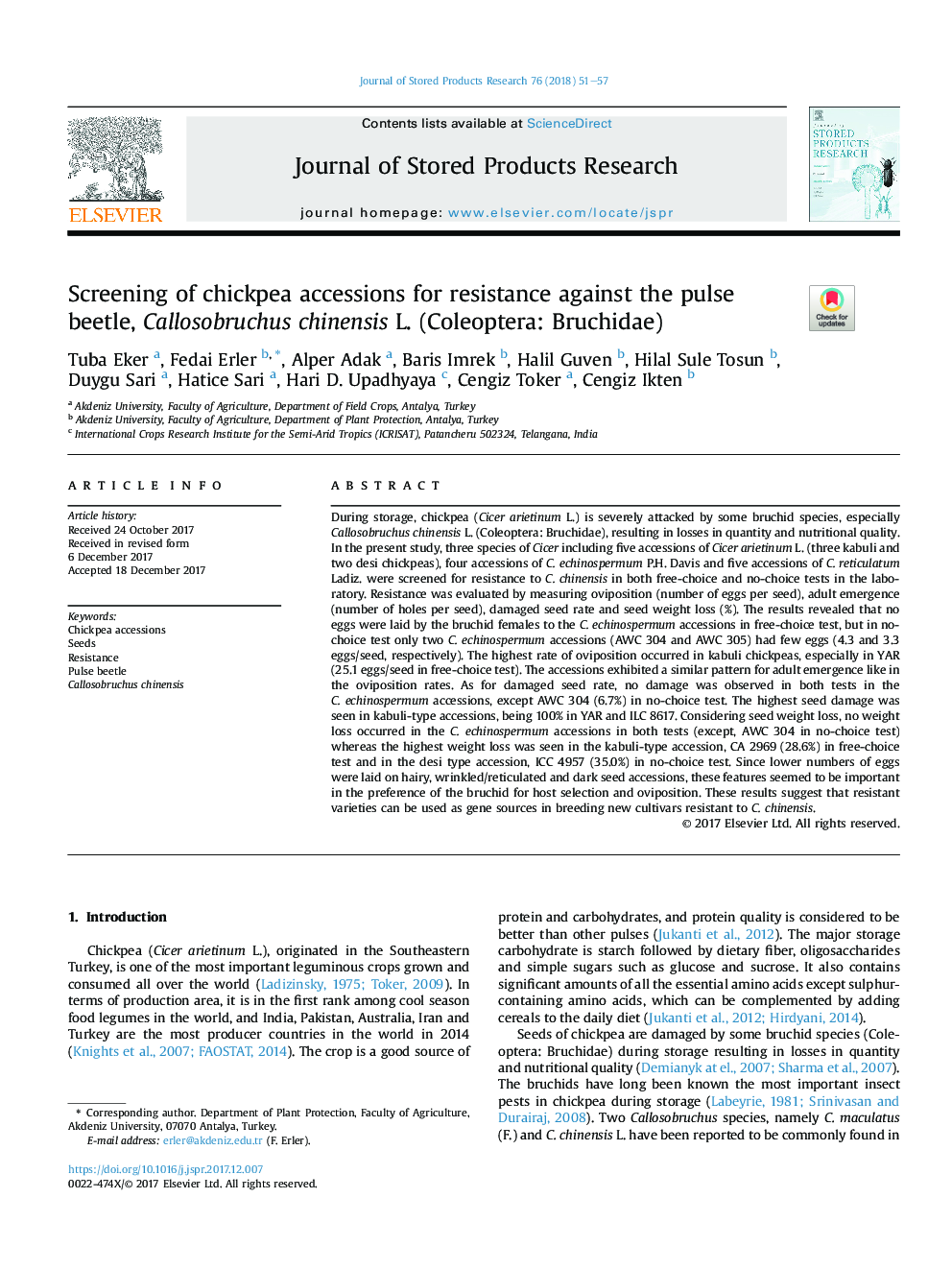| کد مقاله | کد نشریه | سال انتشار | مقاله انگلیسی | نسخه تمام متن |
|---|---|---|---|---|
| 8881668 | 1624913 | 2018 | 7 صفحه PDF | دانلود رایگان |
عنوان انگلیسی مقاله ISI
Screening of chickpea accessions for resistance against the pulse beetle, Callosobruchus chinensis L. (Coleoptera: Bruchidae)
دانلود مقاله + سفارش ترجمه
دانلود مقاله ISI انگلیسی
رایگان برای ایرانیان
موضوعات مرتبط
علوم زیستی و بیوفناوری
علوم کشاورزی و بیولوژیک
علوم زراعت و اصلاح نباتات
پیش نمایش صفحه اول مقاله

چکیده انگلیسی
During storage, chickpea (Cicer arietinum L.) is severely attacked by some bruchid species, especially Callosobruchus chinensis L. (Coleoptera: Bruchidae), resulting in losses in quantity and nutritional quality. In the present study, three species of Cicer including five accessions of Cicer arietinum L. (three kabuli and two desi chickpeas), four accessions of C. echinospermum P.H. Davis and five accessions of C. reticulatum Ladiz. were screened for resistance to C. chinensis in both free-choice and no-choice tests in the laboratory. Resistance was evaluated by measuring oviposition (number of eggs per seed), adult emergence (number of holes per seed), damaged seed rate and seed weight loss (%). The results revealed that no eggs were laid by the bruchid females to the C. echinospermum accessions in free-choice test, but in no-choice test only two C. echinospermum accessions (AWC 304 and AWC 305) had few eggs (4.3 and 3.3 eggs/seed, respectively). The highest rate of oviposition occurred in kabuli chickpeas, especially in YAR (25.1 eggs/seed in free-choice test). The accessions exhibited a similar pattern for adult emergence like in the oviposition rates. As for damaged seed rate, no damage was observed in both tests in the C. echinospermum accessions, except AWC 304 (6.7%) in no-choice test. The highest seed damage was seen in kabuli-type accessions, being 100% in YAR and ILC 8617. Considering seed weight loss, no weight loss occurred in the C. echinospermum accessions in both tests (except, AWC 304 in no-choice test) whereas the highest weight loss was seen in the kabuli-type accession, CA 2969 (28.6%) in free-choice test and in the desi type accession, ICC 4957 (35.0%) in no-choice test. Since lower numbers of eggs were laid on hairy, wrinkled/reticulated and dark seed accessions, these features seemed to be important in the preference of the bruchid for host selection and oviposition. These results suggest that resistant varieties can be used as gene sources in breeding new cultivars resistant to C. chinensis.
ناشر
Database: Elsevier - ScienceDirect (ساینس دایرکت)
Journal: Journal of Stored Products Research - Volume 76, March 2018, Pages 51-57
Journal: Journal of Stored Products Research - Volume 76, March 2018, Pages 51-57
نویسندگان
Tuba Eker, Fedai Erler, Alper Adak, Baris Imrek, Halil Guven, Hilal Sule Tosun, Duygu Sari, Hatice Sari, Hari D. Upadhyaya, Cengiz Toker, Cengiz Ikten,